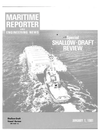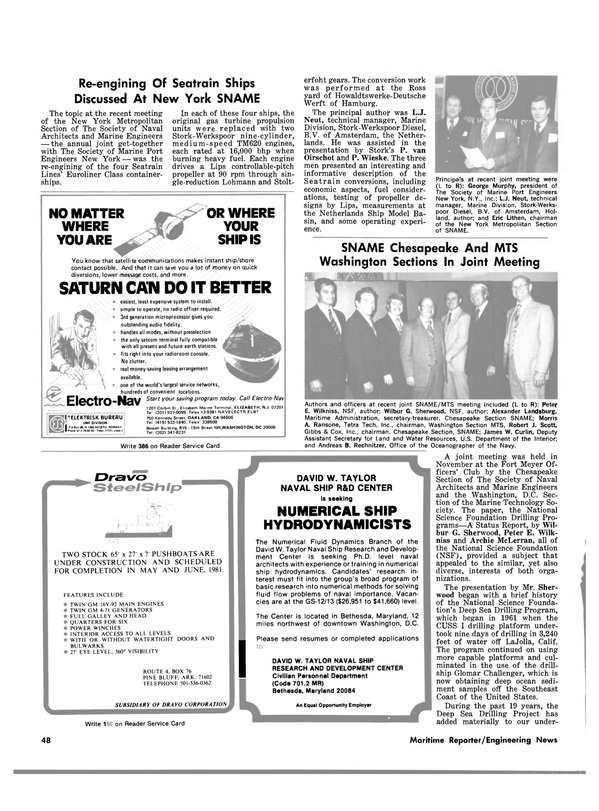
SNAME Chesapeake And MTS Washington Sections In Joint Meeting
A joint meeting was held in November at the Fort Meyer Officers' Club by the Chesapeake Section of The Society of Naval Architects and Marine Engineers and the Washington, D.C. Section of the Marine Technology Society.
The paper, the National Science Foundation Drilling Programs— A Status Report, by Wilbur G. Sherwood, Peter E. Wilkniss and Archie McLerran, all of the National Science Foundation (NSF), provided a subject that appealed to the similar, yet also diverse, interests of both organizations.
The presentation by Mr. Sherwood began with a brief history of the National Science Foundation's Deep Sea Drilling Program, which began in 1961 when the CUSS I drilling platform undertook nine days of drilling in 3,240 feet of water off LaJolla, Calif.
The program continued on using more capable platforms and culminated in the use of the drillship Glomar Challenger, which is now obtaining deep ocean sediment samples off the Southeast Coast of the United States.
During the past 19 years, the Deep Sea Drilling Project has added materially to our under- standing of the earth's crust, including data leading to the development of the plate tectonics model. In addition, s i g n i f i c a nt technical advances in offshore drilling, such as dynamic positioning, satellite navigation, sonar drill hole re-entry techniques, improved core bits and equipment, and improved coring techniques are now being used by the offshore oil drilling and mining industry. Other recent developments include the ability to run intermediate casings in deep water (18,000 feet or greater), successful fishing and recovery of a drill string in 18,000 feet of water, improved deepwater drill string designs, and the development of instruments capable of obtaining data from deep holes.
The limitations of the Glomar Challenger have led to the need for a more capable platform to support a major new initiative, the Ocean Margin Drilling Project, which entails drilling in 13,- 000 feet of water to depths of 20,000 feet below the subsea bottom.
This effort will be jointly funded by the U.S. Government and the oil industry, and primary emphasis will be placed on increasing basic scientific knowledge about the passive ocean margins where thick sediments exist and sophisticated well control techniques and blowout prevention are required.
It is intended to use the Government- owned Glomar Explorer for this program because of its seakeeping and stability characteristics, deadweight capacity, available volume for laboratories, and precise stationkeeping system.
To date, a baseline conceptual design has been completed and NSF intends to complete an updated Baseline Design, including trade-off studies, and to issue a request for proposals for a program systems integration contractor in Fiscal Year 1981.
Read SNAME Chesapeake And MTS Washington Sections In Joint Meeting in Pdf, Flash or Html5 edition of January 1981 Maritime Reporter
Other stories from January 1981 issue
Content
- Zelvin Levine Appointed Advanced Ship Operations Director At MarAd page: 4
- $8.6-Million Contract For Frigate Overhaul Awarded By Navy To BIW page: 6
- Phillips Appointed Gulf Coast General Manager For Designers & Planners page: 6
- Australia Fights Oil Spills With MARCO Class I Skimmers page: 6
- James H. Cottrell Joins Ogden Corporation As Vice President page: 7
- Guralnick Associates Awarded Design Contract By MSC-Pacific page: 7
- $53.2-Million Contract For Supply Boats Signed By Halter page: 7
- Riverway Shipyard Co. Completes Construction Of 120-Foot Tank Barge page: 7
- Combination Gas Tanker 'Hektor' Delivered By Moss Verft page: 8
- Diesel Shipbuilding Delivers Steel Harbor Tug To Ecuador page: 8
- Twin Towing/Supply Vessels Delivered By Quality Shipyards page: 8
- Bulletin On New Fuel Oil Blending Unit Available From IMO page: 9
- Talking Navigator Option From Texas Instruments —Literature Available page: 10
- Australia Receives First Of Four Gas-Turbine-Powered FFGs From Todd Seattle page: 10
- SNAME Los Angeles Section Hears Paper On Noise Control page: 10
- Kockums Sells LNG Ship To West German Consortium page: 10
- New Service Station For Propellers Added At Curacao Drydock Yard page: 11
- Twin-Screw Supply Vessel Delivered By Bender Shipbuilding page: 12
- Three Executive Changes Announced By Ellicott Machine Corporation page: 12
- McDermott International Buys Pipelaying Barge For $85 Million page: 13
- OPS Forms New Marine Design Services Division Roy Thomas Named Director page: 13
- A Review OUTSTANDING U.S. SHALLOW DRAFT VESSELS OF 1980 page: 14
- RYSCO Delivers Another Tug/Supply Vessel To Billy Pugh Offshore page: 14
- APL And Port Of LA. Join To Develop New Container Terminal page: 14
- Electro-Nav To Furnish Electronics Parts And Service For Polish Ships page: 14
- RCA Adds Radiotelephone To Marine Equipment Line —Literature Available page: 16
- Fritz Named Supervisor Of Engineering Computer Operations At J.J. Henry page: 16
- Hitachi To Build Third Jackup Rig For Danish J.L Offshore Drilling page: 18
- J.E. Folsom Named Gulf Region Sales Manager For Hydranautics page: 18
- Simrad Introduces New Microcomputer-Controlled Loran C Navigator page: 19
- Tracor Marine Awarded $8-Million Contract By Rockwell International page: 20
- Joint SNAME/ASNE Meeting Hears Report On SPC Coating page: 20
- Bethlehem's Beaumont Yard Completes Jackup For Temple Drilling page: 21
- Bay Shipbuilding Launches Tank Barge For Hannah Marine page: 22
- Henschel Introduces New Ship's Bell Logger- Literature Available page: 22
- DeJong Designs Biggest Voith Schneider Tug Built In United States page: 23
- National Marine Gets Title XI Approval On $38.5-Million Orders page: 24
- Caterpillar Announces Two Improved Diesels —Free Brochure Available page: 26
- Dravo Corporation Seeking To Acquire Ryan-Walsh Companies page: 26
- MARCO Seattle Christens New North Pacific Fishing Vessel page: 26
- Halter Delivers Two Crewboats For Service Offshore Brazil page: 28
- New Color Brochure On Escher Wyss Props Available At No Cost page: 28
- MSC Will Charter Sun Transport's New Product Carrier 'New York Sun' page: 28
- Bergeron Enters New Product Line With Four Tank Barges page: 29
- Levingston To Build $45-Million Jackup Rig For Noble Drilling Corp page: 29
- Bulkfleet Marine Awards Maintenance System Contract To Stanwick page: 29
- Belcher Towing To Add Powerful Docking Tug To Its Miami Fleet page: 29
- Three New Management Appointments Made At Crowley Maritime page: 30
- Heavy-Lift Derrick Barge Can Lift Up To 400 Tons page: 32
- Ingalls Awarded Fourth Keyes Offshore Contract For Jackup Drilling Rig page: 32
- Jacksonville P.A. To Spend $25.5 Million To Expand Blount Island Facility page: 32
- Wheelock Maritime Ltd. Orders Two Bulkers From China Corporation page: 33
- Norwegian Firm Offers New Control Option For Ship-Handling System page: 33
- Technology Survey Of Major U.S. Shipyards page: 34
- Ingalls Shipbuilding Promotes Three To Vice Presdent Posts page: 34
- New Searchlight Announced By Phoenix Products- Literature Available page: 34
- McDermott Acquires Welding Equipment And Technology From Price page: 34
- McNab Announces Fuel Management System- Literature Available page: 34
- $7.7 Million Authorized For Improvements At Newport News Terminal page: 35
- Worthington Establishes Pump Specialty Shop For Replacement Parts page: 36
- A r e n d a l Y a r d Completes J a c k u p D r i l l i n g Rig For Swedish Owners page: 36
- SSB A n t e n n a I n t r o d u c ed By Phelps D o d g e - L i t e r a t u r e A v a i l a b le page: 37
- Fred Eisenbiegler Named To Board Of Trustees At Webb Institute page: 39
- New Offshore Mooring System Under Development In Scotland page: 39
- Clements Named Group VP At Tracor Components, Succeeding J.D. Hughes page: 41
- J.M. Wilson Named Vice President-Engineering At Philadelphia Resins page: 41
- Walbridge Reelected Chairman Of A I M V - Other Officers Named page: 42
- Steven Moodie To Retire As President And Director Of Interocean Shipping page: 42
- $180-Million Satellite Communications System Approved By INMARSAT page: 42
- Maencor Adds New Management Personnel page: 43
- Senermar Announce New Mini-Computer Version Of FORAN System page: 43
- Marland Licensed To Build And Market New Oil/Water Separator page: 43
- Rados International To Design Purse Seiners For Mexico page: 44
- Bay Shipbuilding Will Build Oceangoing Bulk Cargo Barge For Universal American page: 45
- Bergeron Launches 100th Vessel Built At Its Mississippi Facility page: 45
- General Ship Corporation Yard Is Purchased By Private Investors page: 45
- Promet Gets Orders From Sedco, Sun Contractors For Four Drilling Units page: 46
- Oceangoing Tank Barge Launched At FMC Yard page: 46
- Electric Boat Launches Attack Submarine 'Baltimore' page: 46
- Megasystems Building New $1.5-Million Center In Boca Raton, Florida page: 47
- WOMA Announces New Sales Brochure On Its Water-Blasting Equipment page: 47
- Re-engining Of Seatrain Ships Discussed At New York SNAME page: 48
- SNAME Chesapeake And MTS Washington Sections In Joint Meeting page: 48
- New Firm Will Provide Skilled Workers For Building & Repair Yards page: 49
- Skinner To Produce Steam Engines In New Larger Capacities page: 49
- $1,2-Million Navy Contract For Communications Buoy Awarded To Hazeltine page: 50
- New Ultrasonic Liquid Level Control System Introduced By Inventron page: 50
- New Watch Receiver Announced By DEBEG— Literature Available page: 50
- First Of Three Catug/Barge Units Christened At Avondale Yard page: 58
- SNAME Pacific Northwest Section Holds Meeting In Canada page: 58


